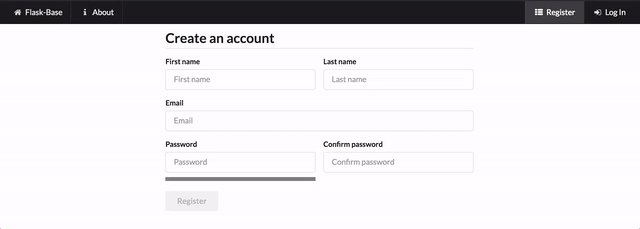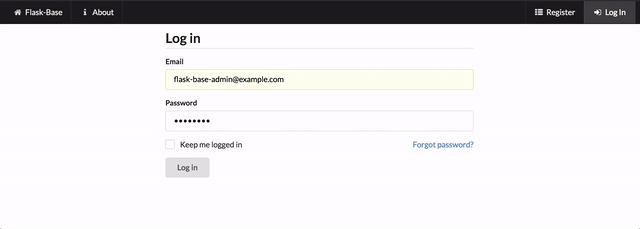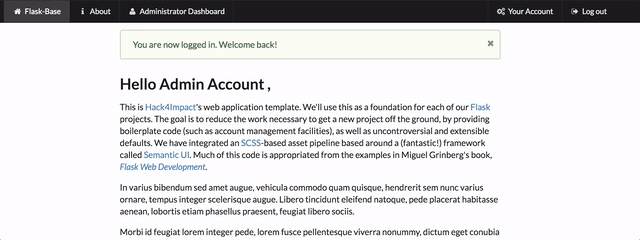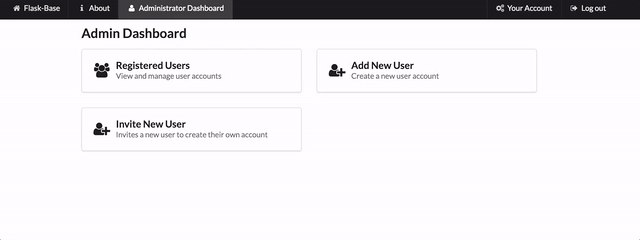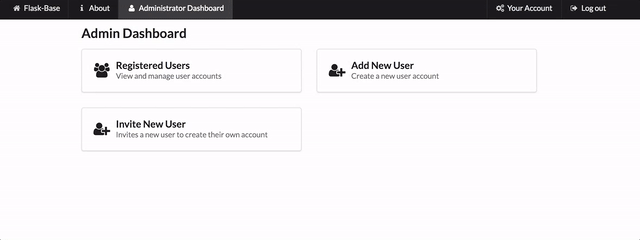flask-base 
 [
[ ] (https://codeclimate.com/github/hack4impact/flask-base/coverage)
] (https://codeclimate.com/github/hack4impact/flask-base/coverage) 
A Flask application template with the boilerplate code already done for you.
Documentation available at http://hack4impact.github.io/flask-base.
What's included?
- Blueprints
- User and permissions management
- Flask-SQLAlchemy for databases
- Flask-WTF for forms
- Flask-Assets for asset management and SCSS compilation
- Flask-Mail for sending emails
- gzip compression
- Redis Queue for handling asynchronous tasks
- ZXCVBN password strength checker
- CKEditor for editing pages
Demos
Home Page:
Registering User:
Admin Homepage:
Admin Editing Page:
Admin Editing Users:
Admin Adding a User:
Setting up
Clone the repo
$ git clone https://github.com/hack4impact/flask-base.git
$ cd flask-base
Initialize a virtualenv
$ pip install virtualenv
$ virtualenv env
$ source env/bin/activate
(If you're on a mac) Make sure xcode tools are installed
$ xcode-select --install
Add Environment Variables
Create a file called config.env that contains environment variables in the following syntax: ENVIRONMENT_VARIABLE=value. For example,
the mailing environment variables can be set as the following. We recommend using Sendgrid for a mailing SMTP server. But anything else will work as well.
MAIL_USERNAME=SendgridUsername
MAIL_PASSWORD=SendgridPassword
SECRET_KEY=SuperRandomStringToBeUsedForEncryption
Note: do not include the .env file in any commits. This should remain private.
Install the dependencies
$ pip install -r requirements.txt
Other dependencies for running locally
You need to install Foreman, Redis, and Sass. Chances are, these commands will work:
Foreman and Sass:
$ gem install foreman
$ gem install sass
Redis:
Mac (using homebrew):
$ brew install redis
Linux:
$ sudo apt-get install redis-server
You will also need to install PostgresQL
Mac (using homebrew):
brew install postgresql
Linux (based on this issue):
sudo apt-get install libpq-dev
Create the database
$ python manage.py recreate_db
Other setup (e.g. creating roles in database)
$ python manage.py setup_dev
Note that this will create an admin user with email and password specified by the ADMIN_EMAIL and ADMIN_PASSWORD config variables. If not specified, they are both flask-base-admin@example.com and password respectively.
[Optional] Add fake data to the database
$ python manage.py add_fake_data
Running the app
$ source env/bin/activate
$ foreman start -f Local
Formatting code
Before you submit changes to flask-base, you may want to auto format your code with python manage.py format.
Contributing
Contributions are welcome! Check out our Waffle board which automatically syncs with this project's GitHub issues. Please refer to our Code of Conduct for more information.
Documentation Changes
To make changes to the documentation refer to the Mkdocs documentation for setup.
To create a new documentation page, add a file to the docs/ directory and edit mkdocs.yml to reference the file.
When the new files are merged into master and pushed to github. Run mkdocs gh-deploy to update the online documentation.



